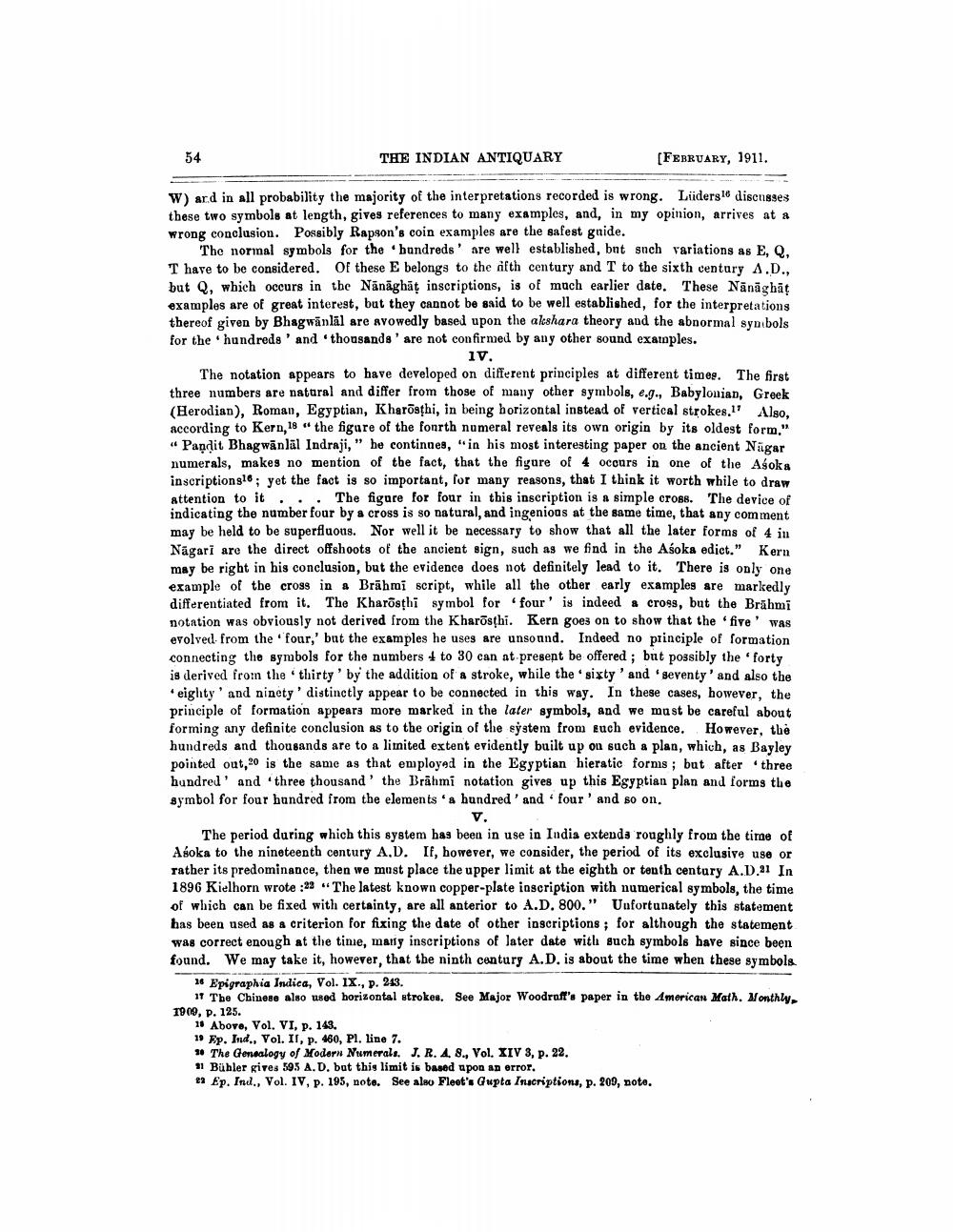________________
54
THE INDIAN ANTIQUARY
(FEBRUARY, 1911.
W) ard in all probability the majority of the interpretations recorded is wrong. Liiders 16 discusses these two symbols at length, gives references to many examples, and, in my opinion, arrives at a wrong conclusion. Possibly Rapson's coin examples are the safest guide.
The normal symbols for the hundreds' are well established, but snch variations as E, Q. T have to be considered. Of these E belongs to the afth century and T to the sixth century A.D., but Q, which occurs in the Nānāghāt inscriptions, is of much earlier date. These Nānäghāt examples are of great interest, but they cannot be said to be well established, for the interpretations thereof given by Bhagwänlāl are avowedly based upon the akshara theory and the abnormal syn bols for the hundreds ' and thousands' are not confirmed by any other sound examples.
iv. The notation appears to have developed on different principles at different times. The first three numbers are natural and differ from those of many other symbols, e.g., Babylonian, Greek (Herodian), Roman, Egyptian, Kharõsthi, in being horizontal instead of vertical strokes." Algo. according to Kern, 18 " the figure of the fonrth numeral reveals its own origin by its oldest form." " Pandit Bhagwanlal Indraji," he continues, "in his most interesting paper on the ancient Nagar numerals, makes no mention of the fact, that the figure of 4 occurs in one of the Asoka inscriptions16; yet the fact is so important, for many reasons, that I think it worth while to draw attention to it ... The figure for four in this inscription is a simple cross. "The device of indicating the number foar by a cross is so natural, and ingenious at the same time, that any comment may be held to be superfluous. Nor well it be necessary to show that all the later forms of 4 in Nāgari are the direct offshoots of the ancient sign, such as we find in the Asoka edict." Kern may be right in his conclusion, but the evidence does not definitely lead to it. There is only one example of the cross in a Brāhmi script, while all the other early examples are markedly differentiated from it. The Kharõsthi symbol for four' is indeed a cross, but the Brāhmi notation was obviously not derived from the Kharõsthi. Kern goes on to show that the five' was evolved from the four,' but the examples he uses are unsound. Indeed no principle of formation connecting the symbols for the numbers to 30 can at present be offered ; but possibly the 'forty is derived from the thirty' by the addition of a stroke, while the sixty' and 'seventy' and also the . eighty' and ninety 'distinctly appear to be connected in this way. In these cases, however, the principle of formation appears more marked in the later symbols, and we mast be careful about forming any definite conclusion as to the origin of the sýstem from Euch evidence. However, the hundreds and thousands are to a limited extent evidently built up on such a plan, which, as Bayley pointed out,20 is the same as that employed in the Egyptian hieratic forms; but after three hundred' and three thousand' the Brāhmi notation gives up this Egyptian plan and forms the symbol for four hundred from the elements a hundred' and four' and so on.
V. The period during which this system has been in use in India extends roughly from the time of Asoka to the nineteenth century A.D. If, however, we consider, the period of its exclusive use or rather its predominance, then we must place the upper limit at the eighth or tenth century A.D.21 In 1896 Kielhorn wrote:22 "The latest known copper-plate inscription with numerical symbols, the time of which can be fixed with certainty, are all anterior to A.D. 800." Unfortunately this statement has been used as a criterion for fixing the date of other inscriptions ; for although the statement was correct enough at the time, mally inscriptions of later date with such symbols have since been found. We may take it, however, that the ninth century A.D. is about the time when these symbols
28 Epigraphia Indica, Vol. IX., p. 243.
11 The Chinese also used horizontal strokes. See Major Woodruft's paper in the American Math. Monthl. 1909, p. 125.
16 Above, Vol. VI, p. 149. 19 Ep. Ind., Vol. II, p. 460, Pl. line 7. ** The Genealogy of Modern Numerals. J.R. 4. 8., Vol. XIV 3, p. 22. 11 Bühler gives 595 A.D. bat this limit is based upon an error.
Ep. Ind., Vol. IV, p. 195, note. See also Fleot's Gupta Inscriptions, p. 209, noto.




